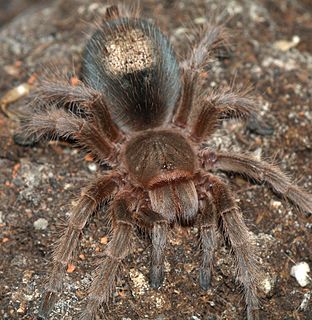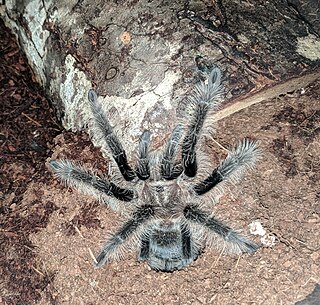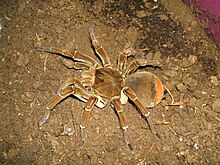
Urticating hairs or urticating bristles are one of the primary defense mechanisms used by numerous plants, almost all New World tarantulas, and various lepidopteran caterpillars. Urtica is Latin for "nettle", and bristles that urticate are characteristic of this type of plant, and many other plants in several families. This term also refers to certain types of barbed bristles that cover the dorsal and posterior surface of a tarantula's or caterpillar's abdomen. Many tarantula species eject bristles from their abdomens, directing them toward potential attackers. These bristles can embed themselves in the other animal's skin or eyes, causing physical irritation, usually to great discomfort. The term urticating hairs is a misnomer, as technically only mammals possess true hairs.

The Goliath birdeater belongs to the tarantula family Theraphosidae. Found in northern South America, it is the largest spider in the world by mass – 175 g (6.2 oz) – and body length – up to 13 cm (5.1 in) – but it is second to the giant huntsman spider by leg span. It is also called the Goliath bird-eating spider; the practice of calling theraphosids "bird-eating" derives from an early 18th-century copper engraving by Maria Sibylla Merian that shows one eating a hummingbird. Despite the spider's name, it only rarely preys on birds.

The Chilean rose tarantula, also known as the rose hair tarantula, the Chilean fire tarantula, or the Chilean red-haired tarantula, is probably the most common species of tarantula available in American and European pet stores today, due to the large number of wild-caught specimens exported cheaply from their native Chile into the pet trade. The species is also known from Bolivia and Argentina.

Brachypelma hamorii is a species of tarantula found in Mexico. It has been confused with B. smithi; both have been called Mexican redknee tarantulas. Many earlier sources referring to B. smithi either do not distinguish between the two species or relate to B. hamorii. B. hamorii is a terrestrial tarantula native to the western faces of the Sierra Madre Occidental and Sierra Madre del Sur mountain ranges in the Mexican states of Colima, Jalisco, and Michoacán. The species is a large spider, adult females having a total body length over 50 mm (2 in) and males having legs up to 75 mm (3 in) long. Mexican redknee tarantulas are a popular choice for enthusiasts. Like most tarantulas, it has a long lifespan.

Lasiodora parahybana, the Brazilian salmon pink bird-eating tarantula, also simply known as the salmon pink or LP, is a tarantula from north-eastern Brazil and considered to be the third largest tarantula in the world.

Aphonopelma chalcodes, commonly known as the western desert tarantula, Arizona blond tarantula or Mexican blond tarantula is a species of spider belonging to the family Theraphosidae. It has a limited distribution in the deserts of Arizona and adjacent parts of Mexico but can be very common within this range. The common name "blond tarantula" refers to the carapace, which is densely covered in pale hairs, and contrasts strongly with the all-dark legs and abdomen. The female body length is up to 56 mm, males only reaching 44 mm.

Phormictopus is a genus of spiders in the family Theraphosidae (tarantulas) that occurs in the West Indies, mainly Cuba and Hispaniola, with three species probably misplaced in this genus found in Brazil and Argentina.

Tliltocatl albopilosus is a species of tarantula, also known as the curlyhair tarantula.

Tarantulas comprise a group of large and often ″hairy″ spiders of the family Theraphosidae. Currently, about 1,000 species have been identified. The term tarantula is usually used to describe members of the family Theraphosidae, although many other members of the same infraorder (Mygalomorphae) are commonly referred to as "tarantulas" or "false tarantulas". Some of the more common species have become popular in the exotic pet trade. Many New World species kept as pets have urticating hairs that can cause irritation to the skin, and in extreme cases, cause damage to the eyes.
Hysterocrates gigas is a member of the tarantula family, Theraphosidae found in Cameroon. It is known as the giant baboon spider, Cameroon red baboon spider, or red baboon tarantula.

The Texas brown tarantula, also known as Oklahoma brown tarantula or Missouri tarantula, is one of the most common species of tarantula living in the Southern United States today. Texas brown tarantulas can grow to leg spans in excess of 4 in (10 cm), and weigh more than 3 oz as adults. Their bodies are dark brown, though shades may vary between individual tarantulas. The colors are more distinct after a molt, as with many arthropods.

Theraphosa apophysis is a species of spider in the family Theraphosidae, found in Venezuela and Brazil.

The skeleton tarantula, Ephebopus murinus, is a species of spider belonging to the family Theraphosidae (tarantulas), sub-family Aviculariinae. A New World species, it is native to several South American countries. Its common name is derived from the skeleton-like markings on its legs.

Aphonopelma anax, commonly known as the Texas tan tarantula, is a species of spider belonging to the family Theraphosidae native to southern Texas and northern Mexico.
Aphonopelma hollyi, also known as the Lubbock gold tarantula, is considered by some sources to be a species of tarantula native to Texas in the United States. Described in 1995, the scientific name honors the 1950s rock-and-roll singer Buddy Holly. Other sources suggest spiders given this name are actually Aphonopelma hentzi.

Aphonopelma marxi is a species of spider in the family Theraphosidae (tarantulas), found in United States. Aphonopelma behlei and A. vogelae, at one time considered separate species, are now considered to be synonyms.

Avicularia juruensis is a species of spider in the family Theraphosidae, found in South America. Avicularia urticans was brought into synonymy in 2017. It has been given the English name Amazonian pink toe spider. Under the synonym Avicularia urticans, it is also known as the Peruvian pinktoe tarantula. It is a large mygalomorph spider, with a maximum body length over 30 mm (1.2 in) and the longest fully extended leg about 60 mm (2.4 in). Like other species in the genus Avicularia, specimens under this name are sold as pets, although their identity has not been confirmed by taxonomic studies.

Tliltocatl kahlenbergi is a species of spider in the family Theraphosidae (tarantulas), found in Mexico.

Tliltocatl schroederi is a species of spiders in the family Theraphosidae (tarantulas), found in Mexico. It is found in the central valley in Oaxaca State, Mexico.

Tliltocatl is a genus of spiders in the tarantula family Theraphosidae. It was split off from Brachypelma in 2020. Species in Tliltocatl are found predominantly in Mexico, with some species native to Central America. They are large burrowing tarantulas, without the striking red leg markings of Brachypelma species.



















